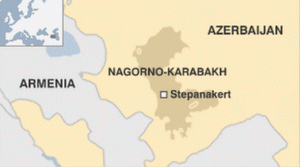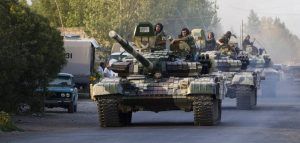
Armenia and Azerbaijan have started hostilities in the disputed Caucausus region of Nagorno-Karabakh.
Overnight fighting saw Azeri and Armenian forces clash with tanks, mortar and artillery, resulting in casualties on both sides. Defense ministries of both nations have accused each other of provocation.
Russia Today reports:
Azerbaijan said Armenian troops opened fire 127 times over 24 hours along the border. They were using mortars and heavy machine guns, the statement released on Saturday morning said.

BYPASS THE CENSORS
Sign up to get unfiltered news delivered straight to your inbox.
You can unsubscribe any time. By subscribing you agree to our Terms of Use
Armenia said Azeri troops went on the offensive overnight and were using tanks, artillery and military aircraft.
18 Armenian soldiers were killed and 35 injured in the fighting with Azerbaijani forces on Saturday, Armenian President Serzh Sargsyan said.
“Since the restoration of the truce in 1994, it’s the most large-scale warfare, which Azerbaijan has tried to carry out,” Sargsyan said at the National Security Council meeting.
Yerevan distinguishes its own armed forces from those of the breakaway republic, while Baku considers them all Armenian.
Militias in the unrecognized Nagorno-Karabakh republic, the focal point of the conflict, claimed they shot down two Azeri helicopter gunboats and two drones, and destroyed at least two tanks. Azerbaijan confirmed losing one helicopter and one tank as well as 12 soldiers.
Baku said it took under its control several strategic points on the border, from which villages on the Azeri side could be threatened by Armenian forces. The sites are currently being fortified by the military, Azerbaijan’s Defense Ministry said.
The ministry claimed it destroyed “six Armenian tanks, 15 artillery pieces, several bunkers and over 100 enemy soldiers.”
The Armenian Defense Ministry has refuted Azerbaijani claims, saying that they “don’t correspond to reality.”
“The Armenian Defense Ministry officially states that information distributed by Azeri media that Azerbaijani armed forces allegedly captured several settlements on the territory of Nagorno-Karabakh region and that losses of the Armenian side amount to dozens in military hardware and hundreds in manpower is blatant disinformation,” the ministry said in a statement.
Nagorno-Karabakh authorities said two teenage students were seriously injured near their school by rocket fire from Azerbaijan. Separate reports in the local media said six civilians and three soldiers were taken to hospital with injuries received during the clashes.
The two countries blamed each other for triggering the escalation.
“The responsibility for the situation is fully on Armenia, the aggressor and occupier nation,” the Azeri Foreign Ministry said in a statement.
Armenia said it condemned the actions of the “Azerbaijan military along the engagement line with Nagorno-Karabakh and the border with Armenia.” Both accused their rival of targeting civilians in Azerbaijan and Nagorno-Karabakh respectively.
Reports from Nagorno-Karabakh say Azerbaijan sent a recon unit across the border overnight. It was intercepted by local forces, said Dmitry Pisarenko, who heads the Armenian branch of the Russian news agency Sputnik. A firefight ensued and rapidly escalated into a major battle, involving tanks, helicopters and artillery, he said.
According to Pisarenko, the fighting “has become less intensive (on Saturday evening) and the situation seems to be gradually de-escalating.”
“Nagorno-Karabakh forces say they have downed two Azeri helicopters and two drones,” he added.
With Azerbaijan and Armenia shifting blame on one another, it’s impossible to establish, which party initiated the hostilities, Aziz Aliev, head of the Sputnik Azeri news agency, told RT.
“Even people, who are there, can’t tell which side is behind the provocation, because the official bodies deny they were the first to start firing,” Aliev said.
“It’s very complicated because Azerbaijan says the conflict started after Armenia shelled its territory and vice versa, so we are waiting for more information to come in,” he added.
Calls for ceasing hostilities
Russian President Vladimir Putin has called on all sides in the conflict to immediately cease hostilities, said Kremlin’s spokesman Dmitry Peskov.
The Russian Foreign Ministry said Moscow was in contact with other members of the OSCE Minsk group, which is tasked with monitoring the Karabakh truce, and was closely watching the development of the situation. The group is currently co-chaired by Russia, the US and France and also includes Belarus, Germany, Italy, Sweden, Finland, Turkey and the two conflicting countries.
The group co-chairs released a statement after a meeting to express their concern with the scale of hostilities and call on the parties involved to avoid further violence. The group said it regretted the loss of lives, including civilians, caused by the clashes.
Concern over the escalation was also voiced by EU Foreign Policy Chief Federica Mogherini, who called on all sides to show restraint and observe the truce. She said the EU supported the mediation effort by the OSCE Minsk group.
Russian Defense Minister Sergey Shoigu held emergency phone talks with his Armenian and Azeri counterparts to discuss how the situation can be defused, the ministry said in a statement.
The two former Soviet republics are locked in a decades-long conflict over Nagorno-Karabakh, a predominantly Armenian mountainous region that was part of Azerbaijan, but broke away in 1988.
The region declared independence in 1991, with a bloody three-year war following it. Russia brokered a ceasefire between Armenia and Azerbaijan in 1994, but the tensions have never actually stopped since then and there is occasional violence.
The mutual distrust between Armenia and Azerbaijan is rooted in a long history of ethnic and religious conflicts in the region as well as their participation in the rivalry of regional heavyweights – the Turks, the Russians and the Persians over the centuries.
Both nations had their first bid for statehood in the wake of the collapse of the Russian Empire in the early 20th century. Among other things their independence resulted in a war in 1918. When Moscow reinstated its control over the region, the conflict was swept under the rug, but never fully extinguished.
The BBC reports dozens killed:
Armenia said 18 ethnic-Armenian soldiers had died in the fighting, among the worst in two decades.
Azerbaijan said it had lost 12 troops and there were unconfirmed reports of civilian deaths on both sides.
Nagorno-Karabakh has been in the hands of ethnic-Armenian separatists since a war that ended in 1994.
Russia, which has sold arms to both sides, called for an immediate ceasefire and for both sides to exercise restraint.
Azerbaijan said its armed forces had come under fire first from large-calibre artillery and grenade-launchers, and that it had taken over two strategic hills and a village.
The Armenian government said Azerbaijan had launched a “massive attack” with tanks, artillery and helicopters.
The Armenian-backed defence ministry in Karabakh said a 12-year-old boy had been killed and two other children injured.
Russian Defence Minister Sergei Shoigu has spoken with his Armenian and Azeri counterparts – Seyran Ohanyan and Zakir Hasanov – by phone, Interfax reported, in an effort to calm the situation.
Fighting between the two sides began in the late 1980s and escalated into full-scale war in 1991 as the Soviet Union collapsed, killing about 30,000 people before a ceasefire in 1994.
The region, which lies inside Azerbaijan but is controlled by ethnic Armenians, has since run its own affairs with Armenian military and financial backing, but clashes break out on a regular basis.
Analysis: Konul Khalilova, BBC Azeri
The fighting that erupted on Friday night is some of the worst since a 1994 ceasefire between the two sides. Azerbaijan says it has taken back two strategically important villages from Armenian army, a claim denied by Armenia. As usual, both sides say the other pulled the trigger first.
There are reports of civilian casualties on both sides. Witnesses told the BBC’s Azeri service that people were being evacuated from villages near to the conflict zone and that others were hiding in basements.
Both President Aliyev of Azerbaijan and Armenia’s President Sargsyan are on their way back from the international nuclear summit in Washington.
Azerbaijan has purchased at least $4bn worth of arms from Russia. Armenia, an important strategic partner of Russia in the Caucasus, also buys weapons from Russia. There are concerns that the fighting could lead to a more wide-scale military conflict.
Leaders on both sides have been blamed for not making enough effort to achieve piece and instead using the conflict as a tool to stay in power. Nationalist sentiment boosted by pro-government media in both societies has been at its height in recent years.
The Organization for Security and Co-operation in Europe (OSCE) has expressed “grave concern” over the reported large-scale ceasefire violations.
The co-chairmen of the body’s Minsk Group – ambassadors Igor Popov of Russia, James Warlick of the US, and Pierre Andrieu of France – issued a joint statement saying: “We strongly condemn the use of force and regret the senseless loss of life, including civilians.
“The co-chairs call upon the sides to stop shooting and take all necessary measures to stabilise the situation on the ground. They reiterate that there is no alternative to a peaceful negotiated solution of the conflict and that war is not an option.”
Frozen conflict over Nagorno-Karabakh
- The conflict has roots dating back over a century to competition between Christian Armenian and Muslim Turkic and Persian influences
- Frictions exploded into violence when the region’s parliament voted to join Armenia in the late 1980s
- The ethnic Azeri population – about 25% of the total before the war – fled Karabakh and Armenia while ethnic Armenians fled the rest of Azerbaijan
- Russian-brokered ceasefire signed in 1994, leaving Karabakh and swathes of Azeri territory around the enclave in Armenian hands
- Progress on a peace process stalled after talks between Armenian and Azeri leaders in 2009. Serious ceasefire violations have followed
- Karabakh is a word of Turkic and Persian origin meaning “black garden”, while “Nagorno” is a Russian word meaning “mountain”

Edmondo Burr
CEO
Assistant Editor
Latest posts by Edmondo Burr (see all)
- Police Arrest Suspect In Supermarket Baby Food Poisoning - October 1, 2017
- Seoul Secures Data From Electromagnetic Interference By N Korea - September 30, 2017
- The ‘World’s First Internet War’ Has Begun: Julian Assange - September 30, 2017


Be the first to comment